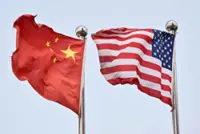The odds of the US economy entering a recession in 2025 are rising. — Reuters
MORE than a month into his second-term administration, US President Donald Trump has signed more than 80 executive orders covering a range of topics including punitive tariffs, government reforms, immigration, border security and more.
The odds of the US economy entering a recession in 2025 are rising. The trade tariffs policy uncertainties and fears of trade war escalation, sinking stock markets, fears of rising prices of goods and services, falling market confidence as well as weakening economic readings have stirred the growth scare.
The on-again, off-again tariff threats have raised considerable uncertainties, prompting businesses and investors to adopt a wait and see approach, or may consider to freeze business investment.
Tariffs retaliation is highly damaging and harmful to global economic growth as they disrupt the supply chains, hamper trade flows, increase inputs cost, and raise prices of goods. Tariff is a tax on consumers as they have to pay more.
The immediate effect of the tit-for-tat tariffs will dampen economic growth and investment as well as push up inflation.
As tariffs are implemented amid sticky inflation and slowing growth, this raises the alarm about stagflation. Stagflation is a rare economic scenario of high inflation and stagnant economic growth.
Stagflation was seen in the US economy in the 70s and 80s.
Such a stagflation effect scenario puts the US Federal Reserve (Fed) in a bind. The Fed faces a tough choice, whether to react to high inflation, which will curb growth, or to support the economy and risk de-anchoring inflation expectations.
The US economy ended the year 2024 on a strong note, printing real gross domestic product (GDP) growth of 2.8% compared with 2.5% in 2023.
However, on a quarterly trend, fourth quarter (4Q) GDP growth has slowed to 2.3% from 3.1% in 3Q24.
Decomposing the growth contribution is not that encouraging.
Household consumption remained resilient (4.2%) while government investment slowed to 2.9% in 4Q from 5.1% in 3Q.
Gross private domestic investment contracted by 5.7% in 4Q for the first time after staying in positive trajectory for six consecutive quarters. Residential investment spending turned positive. Exports are also down moderately.
If the core engines of the economy (consumer spending 68.1% of total GDP) and total private and government investment at 35% of total GDP pulled back sharply, the chances of a technical recession or a meaningful growth slowdown hitting the US economy would rise.
The Fed has done an excellent job to tame inflation without fracturing the US economy.
While the inflation was brought down to 3% in January, it remains above the Fed’s target of 2%, the unemployment rate ticked higher to 4.1% in February.
Is the US economy still on track for a soft landing? Will the US economy be foolproof as during the Trump’s first-term presidency? Back in 2017-2020, the US economy was cruising along not until shattered by the Covid-19 pandemic.
This time around, we see a different dynamic at play under the Trump 2.0. The trade conflicts are wider, covering unilateral tariffs and reciprocal tariffs.
Public debt (US$33.5 trillion or 123% GDP at end-2024) and budget deficit (US$1.83 trillion or 64% of GDP) at all-time high, and the US stock market is overvalued.
Although the Fed has cut interest rates, the monetary policy easing ahead will be a cautious one, as it guards against the upside risks to inflation coming from the tariffs policy.
How will the Trump’s Making America Great Again impact the US economy? Briefly, Trump’s demand-stimulating policies such as deregulation, corporate and personal income taxes cut would raise output.
Highly disruptive
However, the supply constraints such as the highly disruptive tariffs policy will curb demand and boost inflation, and the immigration deportation will tighten the labour market, disrupt supply, push up wages and cause inflation.
Additionally, the Department of Government Efficiency jobs cut and budget spending cut will have contractionary impact on the economy although it helps to reduce budget deficit over time.
We have to recognise that some Trump policies will likely act as countervailing forces to other policies.
The net result of all these demand and supply measures could increase inflationary pressures, forcing the Fed to remain patient about interest-rate reductions, citing uncertainty around the potential impact of the economic policies.
The combination of economic releases and expectations on the growth outlook comes with surveys of consumers and businesses showing decreasing consumer confidence, worries about rising inflation as well as pointing to heightened uncertainty about the economic outlook.
A mixed set of economic readings point to a deceleration in economic growth in the months ahead.
Lack of clarity
The lack of clarity regarding the tariffs is taking its toll. Trump’s tariff policy has created a spike in uncertainty among businesses and investors. The longer it goes on, the greater the uncertainty. Uncertainty is a source of demand restraint.
> The Fed’s own beige book, a collection of anecdotes from hundreds of businesses, mentioned uncertainty 47 times in its latest release, up from just 17 times in January.
> The Atlanta Fed’s GDPNow tracker of incoming data is indicating that US GDP will contract by 2.8% in the first quarter, marking a significant revision from previous estimate of 1.5% contraction.
While the tracker is volatile through the quarter, it does coincide with some other indicators showing a growth slowdown.
Many economists have recorded their estimates for the economy’s growth to as low as 1% at an annual rate in 1Q25, down from 2.3% in 4Q24.
> While the February jobs report painted a picture of stable labour market, it showed some underlying signs of weakness. The jobless rate ticked up to 4.1%, the labour force participation rate dipped, average workweek hours dropped.
The U-6 is broadest measure of unemployment, which includes those who are only marginally attached to the workforce and the underemployed – people who are working part time for economic reasons has ticked higher to 8%, its highest level since October 2021.
> The ADP payroll giant showed that private-sector employment increased by an estimated 77,000 jobs in February, a dramatic drop-off from the strong job growth of 186,000 in January.
> The Conference Board’s Consumer Confidence Index slipped to 98.3 for the month, down nearly 7% and below market expectations. It was the largest monthly drop since August 2021.
Consumers grew more pessimistic about the economic outlook in February as worries brewed about a slowing economy and rising inflation.
The Expectations Index tumbled for the first time since June 2024, and the measure has fallen below the level consistent with recession.
> Retail sales declined 0.9% in January (up 0.7% in December 2024) as stubborn inflation continued to bite and harsh weather curbed economic activity. Personal spending fell 0.2% in January.
> The bond market also has been pricing in slower growth. The three-month Treasury yield moved above the 10-year note, a historically reliable indicator of a recession at the 12 to 18-month horizon.
> The fall in the ISM manufacturing index in February (50.9 versus 50.3 in January) could mark the beginning of the end of the recent mini renaissance, as the reality of the disruption to the sector caused by tariffs starts to set in.
The prices paid index surged to its highest level since June 2022.
> On a positive side, economic activity in the services sector expanded for the eighth consecutive month in February (ISM index at 53.5 versus January’s 52.8).
Lee Heng Guie is the executive director of the Socio-Economic Research Centre. The views expressed here are the writer’s own.





